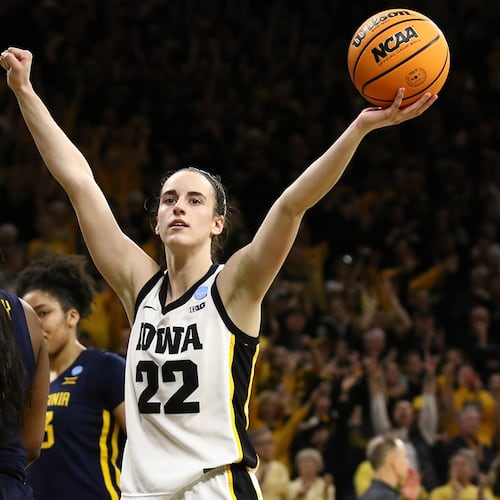The NCAA’s board of governors will meet – virtually; nobody meets in person anymore – Tuesday. SI.com reports the board could move to shutter all fall sports below the FBS level. Put another way, the governing body of college sports might say it’s not OK to play anything yet, unless you’re big enough to have a big-time football program. Which leads us to ask, not for the first or the hundredth time: What exactly does the NCAA govern?
Let’s table that weighty issue for an even more pressing one. If the semi-governing body of college sports believes it’s unsafe for smaller schools to have sports, wouldn’t it be unsafe for the bigger ones, too? And wouldn’t it be tough for the Power Five – when talking collegiate sports, we’re basically talking Power Five football – to have athletes attempt to play even though the NCAA harbors primal doubts about the wisdom of such a move?
The answer’s yes. It would be tough. But that doesn’t mean the final answer – shout-out to Regis Philbin, R.I.P. – would be a no. The Power Five has some reason to believe it can make this work, even if NCAA president Mark Emmert believes otherwise. And here we were thinking no sport could get as tangled as MLB.
The Power Five schools – those in the ACC (plus Notre Dame), the Big Ten, the Big 12, the Pac-12 and the almighty SEC – have money. They can pay for the kind of comprehensive testing and contact tracing that a school in the Patriot League cannot. As MLB is proving on a daily basis, every sport in our time of pandemic is at the mercy of its testing. Some would say that baseball’s first 10 days stand as proof that it’s impossible to conduct a sport without a COVID-19 vaccine. The Power Five could argue otherwise.
First, their fall sports wouldn’t start until September, which might give the virus a chance to recede to more manageable levels. Second, college players will have seen what can happen if protocols aren’t followed. Here, though, we’d note that MLB’s blame-the-Marlins tact of last week rings less true today, seeing as how the Cardinals had no contact with the Fish. We’d also note this: College athletes won’t be in the NBA’s Disney bubble; they’ll be amid thousands of other collegians on campus. Good luck with that.
We’ve mentioned this already, but here it is again: The Power Five is determined to try to play something. This playing might be staged behind locked gates. It might not last beyond the first chill of autumn. But there’s too much money at stake for these five conferences not to make the attempt, provided the virus is no worse than it is today. (Of which there’s absolutely no guarantee.)
Four of the Power Five leagues essentially have gone to conference-only schedules, though it’s unclear what the ACC will do with those plus-ones on which the SEC left them hanging. Believe it or not, the Power Five doesn’t constitute the entirety of FBS football. There are five lesser leagues, known as the Group of Five. Georgia State’s conference, the Sun Belt, is among them.
Given that the P5ers are all but committed to playing only conference games and that the NCAA could proscribe non-FBS schools (like Kennesaw State) from playing at all, it’d be difficult for the Group of Five to plow a lone furrow. Their TV contracts aren’t as big. They don’t send teams to the College Football Playoff. Georgia State Charlie Cobb said in April that football sans fans would be “a worst-case scenario … We’re constantly in this battle of fan support and student engagement. To try to play without fans in the stands, it stunts that growth in ways we probably can’t even fathom from a notoriety and visibility and marketing standpoint.”
We saw from last week’s muscle-flexing between the ACC and SEC that P5 schools don’t care much about each other. They care even less about everyone else. If there’s a way football – and the other fall sports, too – can happen, they’re prepared to give it a go. If there’s a playoff, great. (The CFP has said it will do whatever is necessary to make its event happen.) It could be that three leagues mostly east of the Mississippi – the ACC, Big Ten and SEC – form a more-regional splinter group, leaving the Pac-12 and Big 12 to fend for themselves. It could be that the season ends with the various conference championships.
These aren’t scenarios yours truly has conjured up from the morning mist. These are possibilities that have been discussed at the highest levels of college sports, though the highest level of college sports could be subject to sudden change. If the NCAA says, “We won’t sanction fall sports,” and the Power Five says, “Fine. We’re playing anyway” … well, what’s the point of the NCAA?
There is, however, one detail that could derail even the hell-bent Power Five. To play sports, you need players. Some Pac-12 footballers just threatened to opt out – hey, everybody’s doing it – if they aren’t offered written assurances of “protections and benefits.”
The Washington Post obtained audio of a conference call held last week between SEC health experts and the league’s football student leadership council. Included was this from a Mississippi sports physician: “The problem is that a lot of this (about COVID-19) we don’t know.”
From Texas A&M linebacker Keeath Magee: “As much as you guys don’t know … it’s just kind of not good enough.”
Imagine the reaction if the NCAA shuts down fall sports for the small fry, but the big leagues deem themselves ready and able. What if enough guys who wear helmets in Clemson and Tuscaloosa and Athens and South Bend say, “Sorry, but it’s just kind of not good enough”?
Then nobody plays football. That’s what.
About the Author
The Latest
Featured



